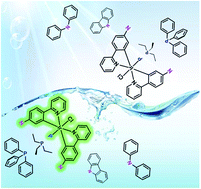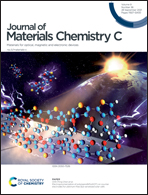IrIII(C^N)2(P-donor ligand)Cl-type complexes bearing functional groups and showing aggregation-induced phosphorescence emission (AIPE) behavior for highly efficient OLEDs†
Abstract
Based on the P-donor ligands of triphenylphosphine and triethylphosphine, a series of IrIII(C^N)2(P-donor ligand)Cl-type complexes bearing C^N ligands with functional groups of diphenylamine and carbazole have been successfully prepared. In dilute solution, these complexes exhibit low phosphorescence quantum yields (ΦP), while much higher ΦP values can be obtained in doped films, indicating their aggregation-induced phosphorescence emission (AIPE) potential. On checking the PL spectra of these IrIII(C^N)2(P-donor ligand)Cl-type complexes in a mixture of THF and water, it has been found that the phosphorescence intensity can be effectively enhanced by increasing the water volume ratio (fw) in THF solution, confirming the obvious AIPE property. In addition, the diphenylamine group can effectively promote the hole injection ability of the concerned complexes, which can benefit the electroluminescence properties. Hence, these IrIII(C^N)2(P-donor ligand)Cl-type complexes can show very impressive EL efficiencies in solution-processed OLEDs with a maximum external quantum efficiency (ηext) of 12.8%, a current efficiency (ηL) of 47.5 cd A−1 and a power efficiency (ηP) of 39.1 lm W−1, representing the best EL results ever achieved by these types of complexes. All these results not only provide valuable information for developing new AIPE molecules but also represent an important way to develop new phosphorescent Ir(III) complexes with high EL ability.



 Please wait while we load your content...
Please wait while we load your content...